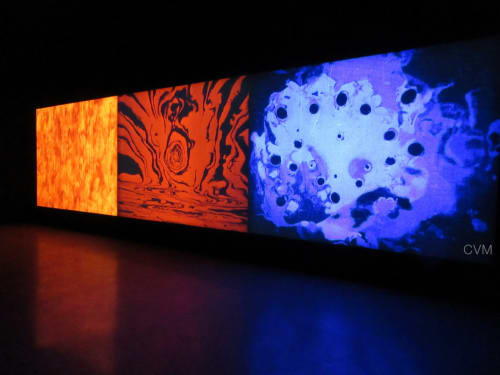Oskar Fischinger — Raumlichtkunst
Everything in the world has a spirit which is released by its sound.
—Oskar Fischinger
Weinstein Gallery is pleased to present the West Coast premiere of the critically acclaimed cinema experience Oskar Fischinger—Raumlichtkunst, c. 1926/2012, HD Reconstruction by Center for Visual Music.
Weinstein Gallery Celebrates 25th Anniversary with the West Coast premiere of Oskar Fischinger’s Raumlichtkunst (c.1926/2012)
"Dazzling...an exhilarating phantasmagoria of abstraction and metaphor" - New York Times Artforum's Best of 2012, Top 10 Lists
San Francisco, Calif., Nov 14, 2017一Weinstein Gallery is pleased to announce the celebration of its 25th Anniversary with the West Coast premiere of the extraordinary avant-garde film experience Raumlichtkunst (c. 1926/2012) by German-American artist Oskar Fischinger, as an HD three-projector reconstruction by Center for Visual Music. Versions of these groundbreaking immersive multimedia performances were originally performed circa 1926 in Weimar Germany by Fischinger, and in 2017 the acclaimed reconstruction will be presented under Weinstein’s PUBLIC programming umbrella at its SOMA warehouse space. Raumlichtkunst, which translates to “Space Light Art,” is a large-scale immersive black box installation with Fischinger’s looped abstract imagery accompanied by avant-garde music. The work is considered an early precursor to expanded cinema, immersive media environments and 1960s psychedelic light shows. The public viewing of Raumlichtkunst (c.1926/2012) and 25th anniversary celebration of the Weinstein Gallery will take place on December 16 from 6:00 to 9:00 and will be free and open to the public.
Oskar Fischinger (1900-1967) was a German-American filmmaker, animator and artist who began performing multiple projector cinema shows in Munich in the 1920s with up to five 35mm film projectors, reels of his abstract films, color filters and slides. His early shows represent some of the first known attempts at creating immersive cinematic environments. Fischinger’s early abstract experiments push aside narrative and reduce cinema to pure plane, scale, motion and color. Many of his other abstract films were screened worldwide, and some are among the first music videos. As the rise of the Third Reich plagued Germany and abstract art became classified as degenerate, Fischinger made contact with studios in Hollywood who sponsored his relocation to America. In the late 1930s Fischinger would go on to contribute and influence films like Fantasia, but ultimately broke with the studio system in order to return to his personal artistic vision.
Raumlichtkunst (c.1926/2012) is an HD black box installation, meticulously restored by the Center for Visual Music (CVM) from Fischinger’s original 1920s 35mm nitrate film, and then digitally reconstructed for exhibition with accompanying music by Varese and John Cage and Lou Harrison. Because few records of the original events exist, this reconstruction captures the concept and experience of the performances rather than representing one particular show. Since the restoration of the work, Raumlichtkunst (c.1926/2012) has been presented at the Whitney Museum, New York in 2012 and again 2016-17; the Tate Modern, London; Palais de Tokyo, Paris; and the Queensland Art Gallery, Brisbane, Australia.
While Raumlichtkunst was created at a pivotal stage in Fischinger’s career, Weinstein Gallery will also exhibit selected works from Fischinger’s practice in order to present a snapshot of the artist’s creative production and his exciting contribution to Modernism. On view will be drawings from his pioneering experiments in synthetic, “ornament” sound in the early 1930s; small paintings used to create the well known short film Radio Dynamics and other paintings made later in his life. Alongside these works, viewers will also be able to view ephemera including correspondence with Hilla Rebay (who sponsored Fischinger in the early 1940s), colleague László Moholy-Nagy, and the Hollywood studios. In addition various ephemera from throughout his animation career and worldwide festivals, screenings and museum exhibitions will be available to view.
On Rowland Weinstein’s decision to present Raumlichtkunst (c.1926/2012)for the 25th anniversary of the gallery, he states:
Over the past 25 years Weinstein Gallery’s program has tracked the movement of Surrealism and Abstract Expressionism from Europe to North America. The story of art from interwar Europe with Surrealists and nonobjective painters has been at the heart of what we exhibit. We want to invite the public to see this seminal work of art from Oskar Fischinger as a way to appreciate the brilliance and innovation that came out of such a fraught time in our global history as a reminder of what the human spirit is capable of, even—and maybe especially—in dark times. Notable for its recent exhibition history in New York and all over the world it made sense to bring this work to the West Coast in a time when our community needs inspiration.
About Oskar Fischinger:
Oskar Fischinger (1900-1967) was a German-American abstract animator, filmmaker, and painter, and widely regarded as the father of visual music; as a grandfather to music videos and motion graphics in general. His films have influenced and inspired generations of filmmakers, animators, and artists into the present. He made over 50 short films and painted around 800 canvases, many of which are in museums, galleries, and collections worldwide. Fischinger also created special effects for Fritz Lang, made color animated commercials in the 1930s, influenced the style of Disney’s Fantasia, and inspired a young John Cage.
Further detailed information on Oskar Fischinger can be found at Center for Visual Music.
Authorized versions of his films are accessible on the Center for Visual Music Vimeo page.
About Center For Visual Music:
Center for Visual Music (CVM) is a nonprofit film archive dedicated to visual music, experimental animation and abstract media. CVM is committed to preservation, curation, education, scholarship, and dissemination of the film, performances and other media of this tradition, together with related historical documentation and artwork. CVM’s films and programs are featured in museums and cultural centers worldwide. CVM’s collections include Fischinger’s films and papers, which they continue to preserve, promote and distribute.
